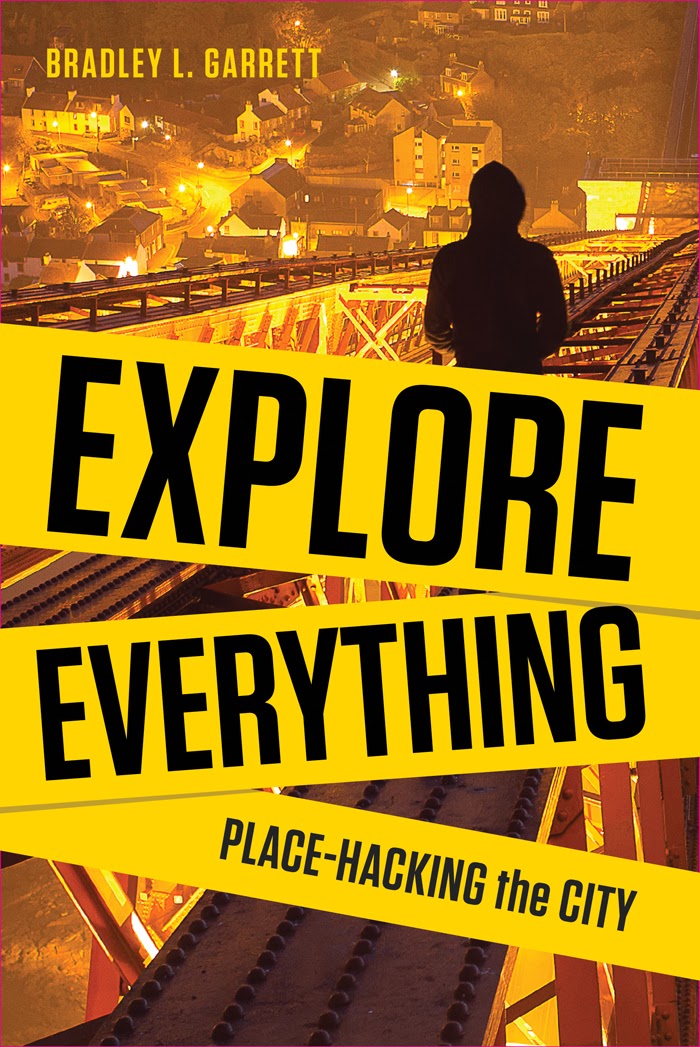A while back, I wrote a post about the phenomenon of Urban Exploration and, in particular, the
work of Bradley Manning, whose book, ‘Explore
Everything: Place Hacking The City’ [1.] had just been published. I obtained
a copy over Christmas and, having just finished reading it, can report that it
is an entertaining, informative and thought provoking read.
American by birth, Garrett is
an Anthropologist and Oxford Academic whose engaging writing style and
exuberant, participatory approach to his subject matter contradict the
stereotypes of such occupations more than a little. ‘Explore
Everything’ is an account of the two years he spent as a member of The
London Consolidation Crew, the British Urban Explorers who became infamous for
scaling ‘The Shard’ tower before its completion and for visiting every one of
London’s disused ghost tube stations.
Indeed, as Garrett
acknowledges, some of the publicity adhering to the LCC and their extensively reported acts of creative trespass, may be in part due to his own presence
within the group. Furthermore, far from
being merely ‘The Scribe Of The Tribe’ [2.],
his efforts to understand and explain the motivations behind their exploits may
have helped to spur them on to ever more intrepid heights, (and depths). The ways in which Anthropological researchers
may inadvertently affect their subjects is clearly something Garrett has
contemplated at some length.
 |
| Upside Down, Beneath London. Photo: Bradley Garrett |
Much of the book’s immediate
appeal lies in its account of a journey into the city’s obscure, forbidden
underbelly, and the intrepid, illegal (in civil law), and often plain dangerous
expeditions that constituted it. There’s
plenty of macho bravado around the UrbEx scene, just as with Parcour, guerrilla
Street Art and other contemporary subcultures, and Garrett certainly entertains
us with accounts of ascents of massive windswept cranes and high buildings,
rope descents into tunnels and drains, and games of midnight cat & mouse
with security guards.
 |
| Beneath London. Photo: Bradley Garrett |
His beautiful, long exposure
photos are spectacular and often steeped in vertigo and/or claustrophobia. They also serve as testament to the achievements
of his crew, being visual trophies in essence, but some time is also spent
considering the aesthetics of such photos, and what they imply about the
motivations behind Urban Exploration. He
is particularly interesting on the subject of ‘Ruin Porn’ and the area of entropy-chic
generally, (something that is making me reflect long and hard on my own
practice).
 |
| Beneath London. Photo: Bradley Garrett |
Indeed, the book expands its
scope in several directions to question both the wider philosophy and politics
of UrbEx and Garrett, quite logically, makes connections with the Situationist
tradition, and with the wider issues of public access versus private interests,
and contemporary ‘Security’ agendas, without pushing any specific dogma. I note with interest that he also references Robert Smithson, an artist who interests me greatly and about who I've written before here. Garrett takes full account of the psychology of
exploration and it's interesting to discover how easily the conscious
historical, geographical, documentary or political agendas he may have started out
with, gave way to a purer quest for ever more stimulating experiences and the
thrill of reaching somewhere secret in the moment.
Garrett is also pretty frank
about the hypocrisies, conflicting viewpoints and internal politics running
through the scene; something he and his compatriots were to eventually fall
foul of. As these, and the long arm of
the London Transport Police, and The State’s post 07:07/pre-Royal Wedding & Olympics paranoia
finally caught up with them, the LCC inevitably started to fragment. Garrett ends his book with tales of their
final expeditions abroad, (partly to escape the heat and publicity at home),
and with reflections on those dispossessed communities forced to make a life
underground, for instance in the storm drains of Las Vegas. He also ponders the future of Urban
Exploration and the prospects for those who will continue to pierce the
increasingly impermeable official surfaces of our modern cities.
 |
| Beneath London. Photo: Dan Salisbury |
Rather than venturing into
deeper analysis of ‘Explore Everything’,
I’ll simply recommend it to anyone who, like myself, finds themselves
fascinated by the idea of ‘The City’ or, indeed, all those just in search of an
interesting read generally. In
conclusion, here’s a passage from the book that particularly stuck in my mind,
“In the practice of urban exploration, it is not the
philosopher or the scientist who interpret spaces but the often uninformed
wanderer searching for knowledge as it presents itself. If, as Dsankt [3.] tells me, we ‘do it because
we want to do it, not out of a grand sense of preservation’, what then can we
learn from taking the unguided tour, where the important historical attributes
of a place are overwhelmed by the sensory, emotional, affective experience of
simply being there?” [4.].
 |
| Beneath London. Photo: Marc Explo |
I’m too old and too cowardly
to climb crane gantries or spelunk the sewers, and unlikely to transgress
beyond the mildest bits of benign trespass.
Nonetheless, that “sensory, emotional, affective experience
of simply being there”, makes
complete sense to me. It’s one of the reasons
I remain an artist.
In addition to ‘Explore Everything’, plenty of interesting
additional material, (Including videos and loads of high quality photography), relating to
Urban Exploration, can be found at:
[1.], [2.] &
[4.]: Bradley L. Garrett, ‘Explore Everything: Place-Hacking The
City’, London, Verso, 2013.

No comments:
Post a Comment